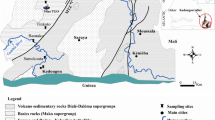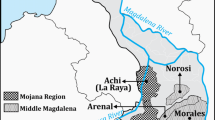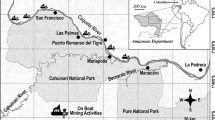Abstract
Gold mining is responsible for most Hg pollution in developing countries. The aims of this study were to assess the levels of total Hg (T-Hg) in human hair, fish, water, macrophyte, and sediment samples in the gold mining district of San Martin de Loba, Colombia, as well as to determine fish consumption-based risks for T-Hg ingestion. T-Hg levels were measured by electrothermal atomization and atomic absorption spectroscopy. The overall mean T-Hg level in hair for humans in the mining district of San Martin de Loba was 2.12 μg/g, whereas for the reference site, Chimichagua, Cesar, it was 0.58 μg/g. Mean T-Hg levels were not different when considered within localities belonging to the mining district but differed when the comparison included Chimichagua. T-Hg levels in examined locations were weakly but significantly associated with age and height, as well as with fish consumption, except in San Martin de Loba. High T-Hg concentrations in fish were detected in Pseudoplatystoma magdaleniatum, Caquetaia kraussii, Ageneiosus pardalis, Cyrtocharax magdalenae, and Triportheus magdalenae, whereas the lowest appeared in Prochilodus magdalenae and Hemiancistrus wilsoni. In terms of Hg exposure due to fish consumption, only these last two species offer some guarantee of low risk for Hg-related health problems. Water, floating macrophytes, and sediments from effluents near mining sites also had high Hg values. In mines of San Martin de Loba and Hatillo de Loba, for instance, the geoaccumulation index (Igeo) for sediments reached values greater than 6, indicating extreme pollution. In short, these data support the presence of a high Hg-polluted environment in this mining district, with direct risk for deleterious effects on the health of the mining communities.







Similar content being viewed by others
References
Alvarez S, Kolok AS, Jimenez LF, Granados C, Palacio JA (2012) Mercury concentrations in muscle and liver tissue of fish from marshes along the Magdalena River, Colombia. Bull Environ Contam Toxicol 89(4):836–840. doi:10.1007/s00128-012-0782-9
Aschner M, Aschner JL (1990) Mercury neurotoxicity: mechanisms of blood-brain barrier transport. Neurosci Biobehav R 14(2):169–176. doi:10.1016/S0149-7634(05)80217-9
Bhuiyan MA, Parvez L, Islam M, Dampare SB, Suzuki S (2010) Heavy metal pollution of coal mine-affected agricultural soils in the northern part of Bangladesh. J Hazard Mater 173(1):384–392. doi:10.1016/j.jhazmat.2009.08.085
Boszke L, Sobczynski T, Glosinska G, Kowalski A, Siepak J (2004) Distribution of mercury and other heavy metals in bottom sediments of the Middle Odra River (Germany/Poland). Pol J Environ Stud 13(5):495–502
Carvalho-Costa L, Piorski N, Willis S, Galetti JP, Ortí G (2011) Molecular systematics of the neotropical shovelnose catfish genus Pseudoplatystoma Bleeker 1862 based on nuclear and mtDNA markers. Mol Phylogenet Evol 59(1):177–194. doi:10.1016/j.ympev.2011.02.005
CCI-INCODER (Corporación Colombia Internacional CCI, Instituto Colombiano de Desarrollo Rural INCODER). (2007) Informe técnico regional cuencas del Magdalena, Sinú y Atrato. Convenio Bogotá (Colombia): CCIINCODER. Available at: http://www.agronet.gov.co/www/docs_agronet/2008924103627_Informetecnicoregional_magdalena_sinu_atrato.pdf
Cesar R, Egler S, Polivanov H, Castilhos Z, Rodrigues AP (2011) Mercury, copper and zinc contamination in soils and fluvial sediments from an abandoned gold mining area in southern Minas Gerais State, Brazil. Environ Earth Sci 64:211–222. doi:10.1007/s12665-010-0840-8
Chien LC, Hung TC, Choang KY, Yeh CY, Meng PJ, Shieh MJ, Han BC (2002) Daily intake of TBT, Cu, Zn, Cd and As for fishermen in Taiwan. Sci Total Environ 285(1):177–185
Copat C, Arena G, Fiore M, Ledda C, Fallico R, Sciacca S, Ferrante M (2013a) Heavy metals concentrations in fish and shellfish from eastern Mediterranean Sea: consumption advisories. Food Chem Toxicol 53:33–37. doi:10.1016/j.fct.2012.11.038
Copat C, Conti GO, Signorelli C, Marmiroli S, Sciacca S, Vinceti M, Ferrante M (2013b) Risk assessment for metals and PAHs by mediterranean seafood. Food Nut Sci 4(7A):10–13. doi:10.4236/fns.2013.47A002
Cordier S, Garel M, Mandereau L, Morcel H, Doineau P, Gosme-Seguret S, Josse D, White R, Amiel-Tison C (2002) Neurodevelopmental investigations among methylmercury-exposed children in French Guiana. Environ Res 89(1):1–11. doi:10.1006/enrs.2002.4349
Dickenson CA, Woodruff TJ, Stotland NE, Dobraca D, Das R (2013) Elevated mercury levels in pregnant woman linked to skin cream from Mexico. Am J Obstet Gynecol 209(2):e4–e5. doi:10.1016/j.ajog.2013.05.030
Duffus JH (2002) Heavy metals a meaningless term?(IUPAC Technical Report). Pure Appl Chem 74(5):793–807. doi:10.1351/pac200274050793
Falandysz J, Dryżałowska A, Saba M, Wang J, Zhang D (2014) Mercury in the fairy-ring of Gymnopus erythropus (Pers.) and Marasmius dryophilus (Bull.) P. Karst. mushrooms from the Gongga Mountain, Eastern Tibetan Plateau. Ecotoxicol Environ Saf 104:18–22. doi:10.1016/j.ecoenv.2014.02.012
Gentès S, Maury-Brachet R, Guyoneaud R, Monperrus M, André JM, Davail S, Legeay A (2013) Mercury bioaccumulation along food webs in temperate aquatic ecosystems colonized by aquatic macrophytes in south western France. Ecotoxicol Environ Saf 91:180–187. doi:10.1016/j.ecoenv.2013.02.001
Heinz GH, Hoffman DJ, Klimstra JD, Stebbins KR, Kondrad SL, Erwin CA (2011) Teratogenic effects of injected methylmercury on avian embryos. Environ Toxicol Chem 30(7):1593–1598. doi:10.1002/etc.530
Hortellani MA, Sarkis JE, Menezes LC, Bazante-Yamaguishi R, Pereira AS, Garcia PF, Maruyama L, Castro PM (2013) Assessment of metal concentration in the billings reservoir sediments, São Paulo State, Southeastern Brazil. J Braz Chem Soc 24(1):58–67. doi:10.1590/S0103-50532013000100009
Hosseini SM, Mirghaffari N, Sufiani NM, Hosseini SV, Ghasemi AF (2013) Risk assessment of the total mercury in Golden gray mullet (Liza aurata) from Caspian Sea. Intl J Aquat Biol 1(6):258–265
Jain RB (2013) Effect of pregnancy on the levels of urinary metals for females aged 17–39 years old: data from National Health and Nutrition Examination Survey 2003–2010. J Toxicol Environ Health Part A 76(2):86–97. doi:10.1080/15287394.2013.738171
Jampeetong A, Brix H, Kantawanichkul S (2012) Effects of inorganic nitrogen forms on growth, morphology, nitrogen uptake capacity and nutrient allocation of four tropical aquatic macrophytes (Salvinia cucullata, Ipomoea aquatica, Cyperus involucratus and Vetiveria zizanioides). Aq Bot 97(1):10–16. doi:10.1016/j.aquabot.2011.10.004
JECFA (2003) Joint FAO/WHO Expert Committee on Food Additives. Sixty-first meeting; 10–19 June; Rome. p. 9. Summary and Conclusion, JECFA/61/SC
JECFA (2010) Joint FAO/WHO Expert committee on food additives. Seventy-second meeting. Rome, 16–25 February 2010. Summary and conclusions. JECFA/72/SC. Food and Agriculture Organization of the United Nations World Health Organization. Issued 16th March 2010
Kajiwara Y, Yasutake A, Adachi T, Hirayama K (1996) Methylmercury transport across the placenta via neutral amino acid carrier. Arch Toxicol 70(5):310–314
Kasper D, Botaro D, Palermo EFA, Malm O (2007) Mercúrio em peixes-fontes e contaminação. Oecol Bras 11(2):228–239
Kwaansa-Ansah E, Agorku S, Nriagu J (2011) Levels of total mercury in different fish species and sediments from the Upper Volta Basin at Yeji in Ghana. Bull Environ Contam Toxicol 86(4):406–409. doi:10.1007/s00128-011-0214-2
Lage-Pinto F, Oliveira JG, Da Cunha M, Souza CM, Rezende CE, Azevedo RA, Vitória AP (2008) Chlorophyll fluorescence and ultrastructural changes in chloroplast of water hyacinth as indicators of environmental stress. Environ Exp Bot 64(3):307–313. doi:10.1016/j.envexpbot.2008.07.007
Lebel J, Mergler D, Branches F, Lucotte M, Amorim M, Larribe F, Dolbec J (1998) Neurotoxic effects of low-level methylmercury contamination in the Amazonian Basin. Environ Res 79(1):20–32. doi:10.1006/enrs.1998.3846
Lecce SA, Pavlowsky RT (2014) Floodplain storage of sediment contaminated by mercury and copper from historic gold mining at Gold Hill, North Carolina, USA. Geomorphology 206:122–132
Llop S, Guxens M, Murcia M, Lertxundi A, Ramon R, Riaño I, Rebagliato M, Ibarluzea J, Tardon A, Sunyer J, Ballester F (2012) Prenatal exposure to mercury and infant neurodevelopment in a multicenter cohort in Spain: study of potential modifiers. Am J Epidemiol 175(5):451–465. doi:10.1093/aje/kwr328
Lu X, Kruatrachue M, Pokethitiyook P, Homyok K (2004) Removal of cadmium and Zinc by Water Hyacinth Eichhorrnia crassipes. Sci Asia 30:93–103
Marrugo-Negrete J, Benitez LN, Olivero-Verbel J (2008) Distribution of mercury in several environmental compartments in an aquatic ecosystem impacted by gold mining in northern Colombia. Arch Environ Contam Toxicol 55(2):305–316. doi:10.1007/s00244-007-9129-7
Marrugo-Negrete J, Benítez LN, Olivero-Verbel J, Lans E, Gutierrez FV (2010) Spatial and seasonal mercury distribution in the Ayapel Marsh, Mojana region, Colombia. Inter J Environ Health Res 20(6):451–459. doi:10.1080/09603123.2010.499451
Martinez-Finley EJ, Aschner M (2014) Recent advances in mercury research. Curr Environ Health Rep 1(2):163–171. doi:10.1007/s40572-014-0014-z
McAloon KM, Mason RP (2003) Investigations into the bioavailability and bioaccumulation of mercury and other trace metals to the sea cucumber, Sclerodactyla briareus, using in vitro solubilization. Mar Pollut Bull 46(12):1600–1608. doi:10.1016/S0025-326X(03)00326-6
Mechora Š, Germ M, Stibilj V (2014) Monitoring of selenium in macrophytes—the case of Slovenia. Chemosphere 111:464–470. doi:10.1016/j.chemosphere.2014.03.133
Miller MB, Gustin MS, Eckley CS (2011) Measurement and scaling of air–surface mercury exchange from substrates in the vicinity of two Nevada gold mines. Sci Total Environ 409(19):3879–3886. doi:10.1016/j.scitotenv.2011.05.040
Mishra KK, Raí UN, Prakash O (2007) Bioconcentration and phytotoxicity of Cd in Eichhornia crassipes. Environ Monit Assess 130:237–243. doi:10.1007/s10661-006-9392-5
Muller G (1969) Index of geoaccumulation in sediments of the Rhine River. Geojournal 2(3):108–118
Olivero-Verbel J, Caballero-Gallardo K (2013) Nematode and mercury content in freshwater fish belonging to different trophic levels. Parasitol Res 112(6):2187–2195. doi:10.1007/s00436-013-3378-3
Olivero-Verbel J, Caballero-Gallardo K, Negrete-Marrugo J (2011) Relationship between localization of gold mining areas and hair mercury levels in people from Bolivar, North of Colombia. Biol Trace Elem Res 144(1–3):118–132. doi:10.1007/s12011-011-9046-5
Olivero-Verbel J, Caballero-Gallardo K, Torres-Fuentes N (2009) Assessment of mercury in muscle of fish from Cartagena Bay, a tropical estuary at the north of Colombia. Inter J Environ Health Res 19(5):343–355. doi:10.1080/09603120902749090
Qiu G, Feng X, Wang S, Fu X, Shang L (2009) Mercury distribution and speciation in water and fish from abandoned Hg mines in Wanshan, Guizhou province, China. Sci Total Environ 407(18):5162–5168. doi:10.1016/j.scitotenv.2009.06.007
Ralston NV, Raymond LJ (2010) Dietary selenium’s protective effects against methylmercury toxicity. Toxicology 278(1):112–23. doi:10.1016/j.tox.2010.06.004
Richardson M (1996) The safety of dental amalgam, ISBN 0-662-24873-2. Minister of Health, Canada
Sadagoparamanujam V, Wilson DT, Ramanujam CL, Lederman RP, Grady JJ, Alcock NW (2011) Mercury exposure through diet in pregnant women and women of childbearing age. Toxicol Environ Chem 93(10):2098–2110. doi:10.1080/02772248.2011.625621
Sholupov S, Pogarev S, Ryzhov V, Mashyanov N, Stroganov A (2004) Zeeman atomic absorption spectrometer RA-915+ for direct determination of mercury in air and complex matrix samples. Fuel Process Technol 85(6):473–485. doi:10.1016/j.fuproc.2003.11.003
Silbernagel SM, Carpenter DO, Gilbert SG, Gochfeld M, Groth E, Hightower JM, Schiavone FM (2011) Recognizing and preventing overexposure to methylmercury from fish and seafood consumption: information for physicians. J Toxicol 2011:1–7. doi:10.1155/2011/983072
Sonne C, Leifsson PS, Dietz R (2013) Liver and renal lesions in mercury-contaminated narwhals (Monodon monoceros) from North West Greenland. Toxicol Environ Chem 95(3):1–14. doi:10.1080/02772248.2013.783666
Tomiyasu T, Kono Y, Kodamatani H, Hidayati N, Rahajoe JS (2013) The distribution of mercury around the small-scale gold mining area along the Cikaniki river, Bogor, Indonesia. Environ Res 125:12–19. doi:10.1016/j.envres.2013.03.015
US-EPA (1989) Risk Assessment Guidance for Superfund, vol. I. Human Health Evaluation Manual (Part A), Interim Final. EPA 540/1–89/002. United States Environmental Protection Agency, Washington, DC
US-EPA (1994) Methods 245.1 for determination of mercury in water. U.S. Environmental protection Agency. Cincinnati. Ohio
US-EPA (2000) Guidance for Assessing Chemical Contamination Data for Use in Fish Advisories, vol. II. Risk Assessment and Fish Consumption Limits EPA/823-B94-004. United States Environmental Protection Agency, Washington, DC
Veiga M (2010) Antioquia, Colombia: the world’s most polluted place by mercury: impressions from two field trips. United Nations Industrial Development Organization, Vienna, pp 1–24
Vesk PA, Nockolds CE, Allaway WG (1999) Metal localization in water hyacinth root from an urban rainyland. Plant Cell Environ 22:149–158
Woods JS, Heyer NJ, Russo JE, Martin MD, Pillai PB, Farin FM (2013) Modification of neurobehavioral effects of mercury by genetic polymorphisms of metallothionein in children. Neurotoxicol Teratol 39:36–44. doi:10.1016/j.ntt.2013.06.004
World Health Organization (1991) Inorganic mercury: environmental health criteria 118, in International Programme on Chemical Safety. World Health Organization, Geneva
Zhu L, Yan B, Wang L, Pan X (2012) Mercury concentration in the muscle of seven fish species from Chagan Lake, Northeast China. Environ Monit Assess 184(3):1299–1310. doi:10.1007/s10661-011-2041-7
Zhu YL, Zayed AM, Qian JH, De Souza M, Terry N (1999) Phytoaccumulation of trace elements by wetland plants: II. Water Hyacinth. J Env Qual 28(1):339–344. doi:10.2134/jeq1999.00472425002800010042x
Acknowledgments
The authors thank the Program to Support Research Groups, sponsored by the Vice-Rectory for Research of the University of Cartagena (2013–2014); the Ph. D Program in Environmental Toxicology at the same institution; the National Program for Doctoral Formation (COLCIENCIAS, 567–2012); the Government of Bolivar State, Colombia; and Leonor Cervantes.
Conflict of interest
None.
Author information
Authors and Affiliations
Corresponding author
Additional information
Responsible editor: Philippe Garrigues
Rights and permissions
About this article
Cite this article
Olivero-Verbel, J., Caballero-Gallardo, K. & Turizo-Tapia, A. Mercury in the gold mining district of San Martin de Loba, South of Bolivar (Colombia). Environ Sci Pollut Res 22, 5895–5907 (2015). https://doi.org/10.1007/s11356-014-3724-8
Received:
Accepted:
Published:
Issue Date:
DOI: https://doi.org/10.1007/s11356-014-3724-8




